



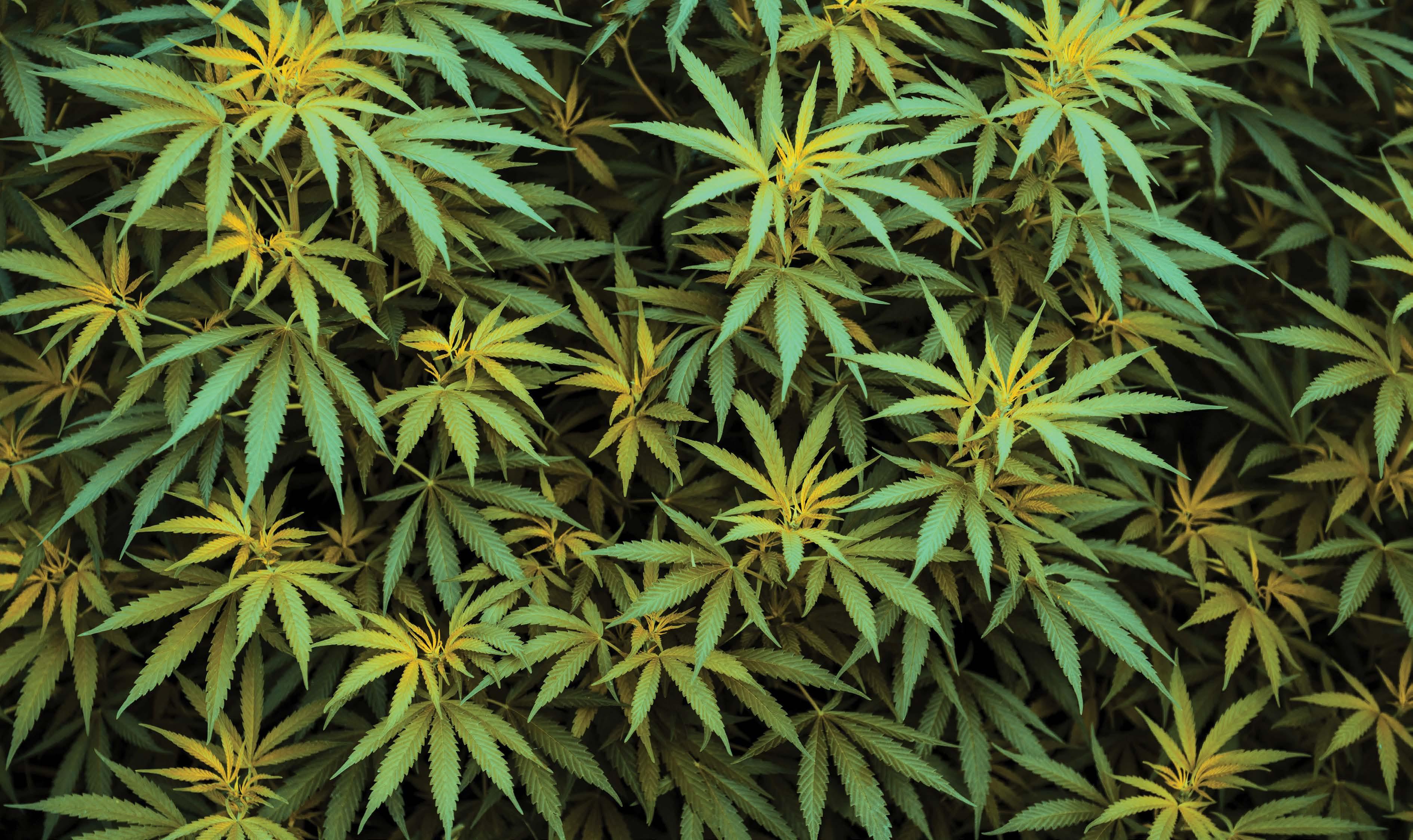



























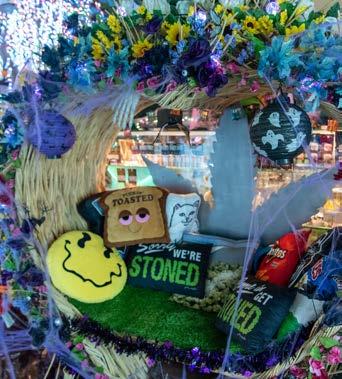















WES ABNEY CEO & FOUNDER wes@leafmagazines.com
MIKE RICKER OPERATING PARTNER ricker@leafmagazines.com | advertising sales
TOM BOWERS CHIEF OPERATING OFFICER tom@leafmagazines.com
DANIEL BERMAN CHIEF CREATIVE OFFICER daniel@leafmagazines.com
BOBBY BLACK LEAF BOWL DIRECTOR & HISTORIAN bobbyblack@leafmagazines.com
MICHELLE NARANJO COPY EDITOR michelle@leafmagazines.com
MATT JACKSON SOCIAL MEDIA LEAD mattjackson@leafmagazines.com

Northwest Leaf is proud to present our annual celebration of the art of sun-grown Cannabis by some of the state’s finest cultivators. Landing on the cover this month was a stunning close-up shot of Powder Hound, grown by Lazy Bee Gardens in the small Okanogan County town of Winthrop in eastern Washington. The Leaf’s Mike Ricker interviewed owner Matthew Frigone Bernhard, the farm’s owner, about pheno hunting their newest strains and what’s behind their relentless drive for innovation, harvest after harvest. pg. 40-42
PHOTO BY MORETA FIONA @MFJANE
WES ABNEY, FEATURES
ANGELA-JORDAN AGUILAR, FEATURES
DANIEL BERMAN, PHOTOS + DESIGNS
RYAN JOHNSON BITAR, PHOTOS
BOBBY BLACK, FEATURES + DESIGN
NEIL BRAYBROOK, PHOTOS
JACKIE BRYANT, FEATURES
ALEEN CAELI, PHOTOS
DAVID DOWNS, FEATURES
MORETA FIONA, PHOTOS
REX HILSINGER, FEATURES + PHOTOS
ELLEN HOLLAND, FEATURES
MATT JACKSON, FEATURES
LENA B. MONAGHAN, AD S ALES + PRODUCTION
BENJAMIN NEFF, PHOTOS
MIKE RICKER, FEATURES
CHRIS ROMAINE, PHOTOS
MARC ROSSMAN, PHOTOS
KEENAN SHUR, ILLUSTRATION
TERPENE TRANSIT, DISTRIBUTION
TERPODACTYL MEDIA, FEATURES + PHOTOS
NATE WILLIAMS, PHOTOS
We are creators of targeted, independent Cannabis journalism. Please email us to discuss advertising in the next issue of Northwest Leaf Magazine. We do not sell stories or coverage. Email ricker@leafmagazines.com to start advertising!


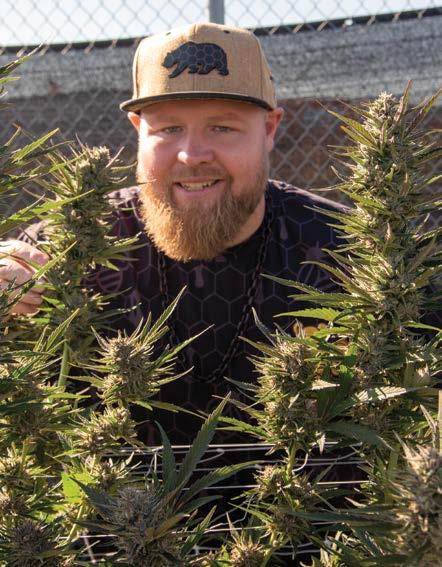
Harvest is a season of bounty, a reward for a long spring and summer of faith, work and long days.
Today, we’re used to hitting the grocery store and seeing bananas, apples and oranges year-round, but that’s not how life was only a few generations ago. Humans lived seasonally for hundreds of thousands of years, ebbing and flowing with nature, and enjoying the bounty provided depending on the time of year.
While our food is available 24/7, thanks to a global supply chain, those of us old enough to have bought weed illegally remember the flow of fire around November and the late-summer drought, as all of last year’s weed was gone. Today’s stoners know nothing of the shortages or a dealer being out of weed. Neighborhood dispensaries are open seven days a week and bursting with amazing ways to get high, delivering medicinal and recreational relief on demand.
“TODAY’S STONERS KNOW NOTHING OF THE SHORTAGES OR A DEALER BEING OUT OF WEED.”
The reason we have vapes, edibles, concentrates and topicals galore — along with delicious, terpy sun-kissed flowers — is hardworking farmers whose hands are in the dirt for nine months a year. Our industry runs on sun-grown Cannabis, whether it’s light deps, greenhouse or full-term flower. From native soil to raised beds of living soil, or a broad field full of autoflowering phenos that slap, there’s a farmer in the sun, rain and mud to thank for your next hit.
That’s why our Harvest Issue has been running since 2011. We at the Leaf recognize and celebrate the farm, where our roots begin and end, with people who work hard, smoke hard and have grown Cannabis since the medical-only and prelegal days and for generations. The knowledge, passion and cost of isolation are all part of a culture and legacy that means so much more than a price per pound.
We must thank and protect our outdoor farmers who serve the entire Cannabis ecosystem. They keep the machines of industry flowing and fill more shelves directly and indirectly than any other segment of the market. They’re responsible for the sweet honey of THC in the same way God is a provider of our abundance, the plant and our natural world. Cannabis is a gift that keeps giving, harvest after harvest, and that overflowing bowl is a promise kept that we should be grateful for this season.









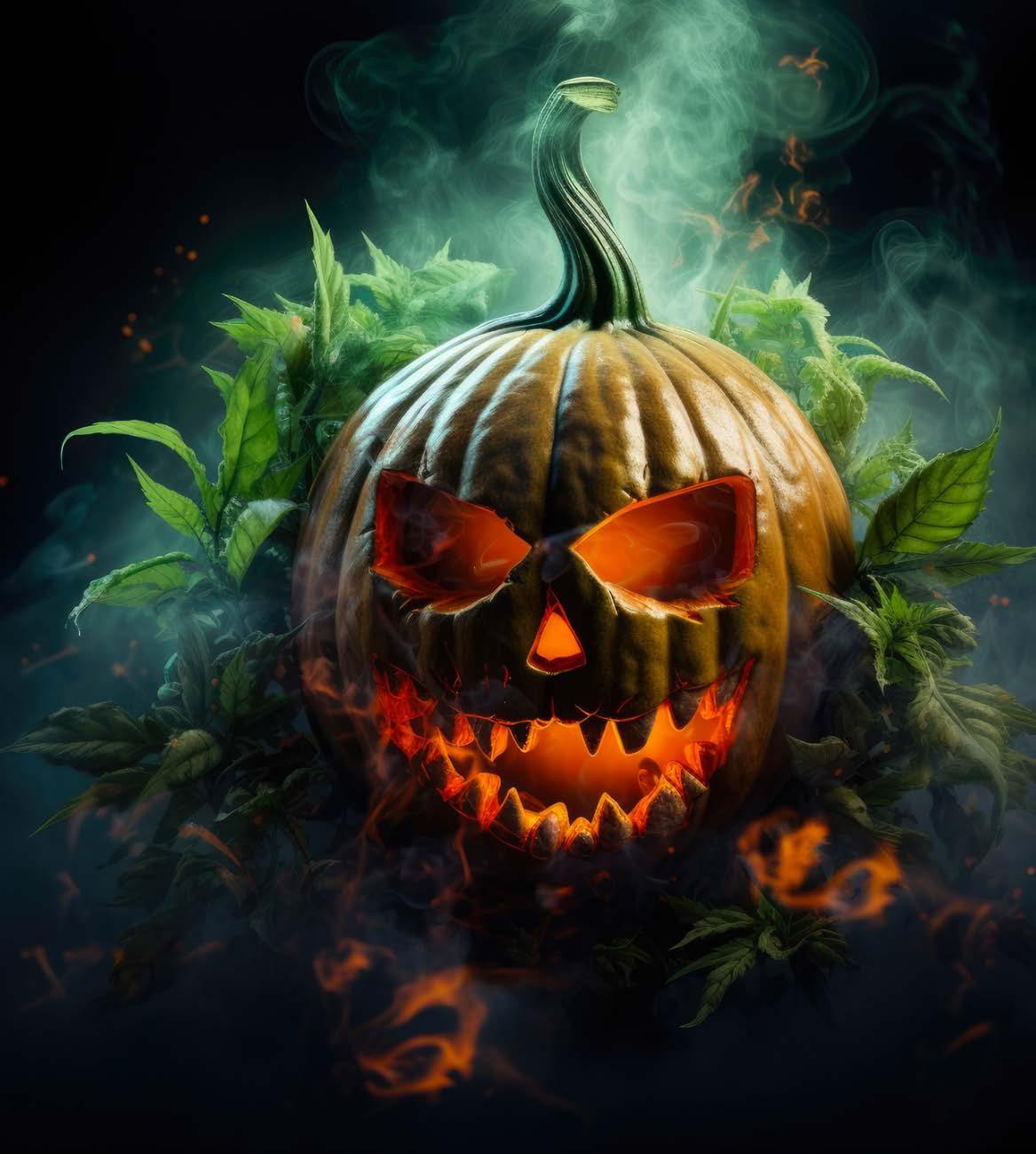

OVER 2,000 adults gathered at Joint Rivers for the first Washington edition of Halloweird, where tricks, treats and free tattoos greeted guests who registered for their free tickets.
With classic Halloween tunes spinning in the background, guests explored brand booths and visited our experience sponsors, including free tattoos at the PRC booth, caricatures at the Agro Couture booth and a beautiful lounge setup by House of Cultivar. The photo booth was a big hit, with OCB providing this service, allowing guests to commemorate their costumes and grins with a custom photo strip.
Joint Rivers hosted the event, and we thank the entire team for making this a memorable time!





























This product has intoxicating effects and may be habit forming. Marijuana can impair concentration, coordination, and judgment. Do not operate a vehicle or machinery under the influence of this drug. There may be health risks associated with consumption of this product. For use only by adults twenty-one and older. Keep out of the reach of children.



Russ Gress, store lead at The Slow Burn, lives in the Yakima Valley and spends a lot of his days helping locals decide on their preferred Cannabis products. His professional Cannabis journey has taken him to a wide range of areas: from the beautiful community of Boulder Creek in the Santa Cruz Mountains of California to the historic and rustic city of Monroe in Green County, Wisconsin, before finally finding his way back to his hometown, the hop fields of Moxee.

IN HIS FREE TIME, RUSS IS AN ACCOMPLISHED CANNAPHOTOG AND ENROLLED AT GONZAGA UNIVERSITY ...

A RELAXED DEMEANOR, positive vibe and constant smile make Russ easily approachable.
After spending almost six years in the industry, his level of knowledge is apparent when it comes to the wide array of products at The Slow Burn.
RUSS’ RECS
Flower
Dank Czar Honey
Yakima Valley residents are very focused on agriculture and local businesses. The Slow Burn location Northwest Leaf visited embodies that focus, as it is a little more of a boutique store that attracts clients who are seeking out particular terpene experiences and small-batch/craft brands as opposed to larger producers. A local favorite Russ really believes in is Sungaze Cannabis Company, a brand that provides an entry-level product produced by local farm Painted Rooster Cannabis Company.
Banana Bread
Edible
Pioneer Squares
Watermelon Kiwi
Vapes
Trichome Extracts
Lemon Meringue
When Russ isn’t fulfilling his responsibilities across The Slow Burn’s four retail locations, he spends his time wisely. He’s had a hard concentration on Cannabis photography for about 12 years, and it shows.
Russ is also big on physical fitness and can be found on a hike or in the gym daily.
And if that’s not enough extracurricular activities for you, he is also enrolled in Gonzaga University’s Cannabis Compliance and Risk Management program. This educational pursuit allows him to constantly grow his scientific knowledge about the plant down to the molecular level. One day, he hopes to take this knowledge and help our state’s governmental departments better understand not only the benefits but the market as a whole.
“I think the LCB needs people that have actual feet-on-the-ground knowledge to help inform them and understand what a lot of these products are and their actual intentions for the end user,” Russ said.
He hopes that, in the future, the reclassification of Cannabis will make way for the evolution of medical research involving the plant, education on the benefits and utilization of insurance and other resources to include Cannabis-based medical solutions.
If you’re near one of The Slow Burn locations, pop in and meet our friend Russ. He’ll guide you to something delicious that has the benefits you’re looking for.


























Happy Trees is a different kind of store, where imagination meets the physical world. Beyond the amazing facade created for the mind’s eye, the attention to detail is far beyond the typical retail store. Founder Paul Brice has been in the industry since the medical days and knows that providing an experience matched with quality products and customer care is what keeps people coming back to find “their happy.”
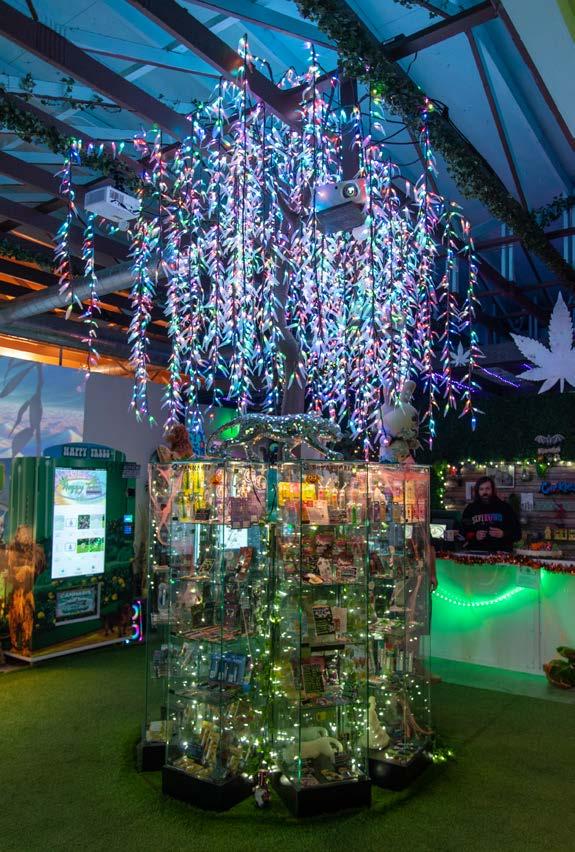
FOUNDER PAUL BRICE has been in the industry since the medical days and knows that providing an experience matched with quality products and customer care is what keeps people coming back to find “their happy.”
Paul Daley, the store manager, was on hand, and he also has a lot of experience in the industry. This is a passion project for him. He considers being a part of the community a gift and wants to help patients and consumers alike find the best products available on the market, all while doing it in a safe and serene environment.
I really enjoy the energy as you first walk through the door, as well as the curated sections for different types of products. The “Hall of J’z” and constantly running projections on every available wall space really stand out. The entire shop was decorated for Halloween when the Northwest Leaf visited, but the team changes it up for every season and holiday. The huge center column display of vapes, the wall of edibles and the wide array of concentrates are second to none.
At the Happy Trees store, I definitely didn’t feel like I was in a small farm town in southeast Washington. Wes Abney, founder of the Northwest Leaf, describes it as a “weed Meow Wolf.” On top of the available selections, Happy Trees is also known for its impressive vendor days that usually feature two to three producers at a time in a nice open side area just outside the main store.



Now, let’s talk about the vending machines that Brice refers to as his “crash ’n’ grab displays.” The vending machine system — a popular topic among Washington’s retailers for years — is executed proficiently by the Happy Trees team. Vending machines add another layer of security between would-be thieves and these stores’ valuable inventories. Additionally, these machines allow customers to view a larger selection of products in a familiar and easily accessible manner. It’s not the only way to shop at Happy Trees, but this system adds another dimension to what’s out there.
If you find yourself in the Yakima Valley or Cle Elum areas, don’t miss this stop — it’s like stepping into another world!









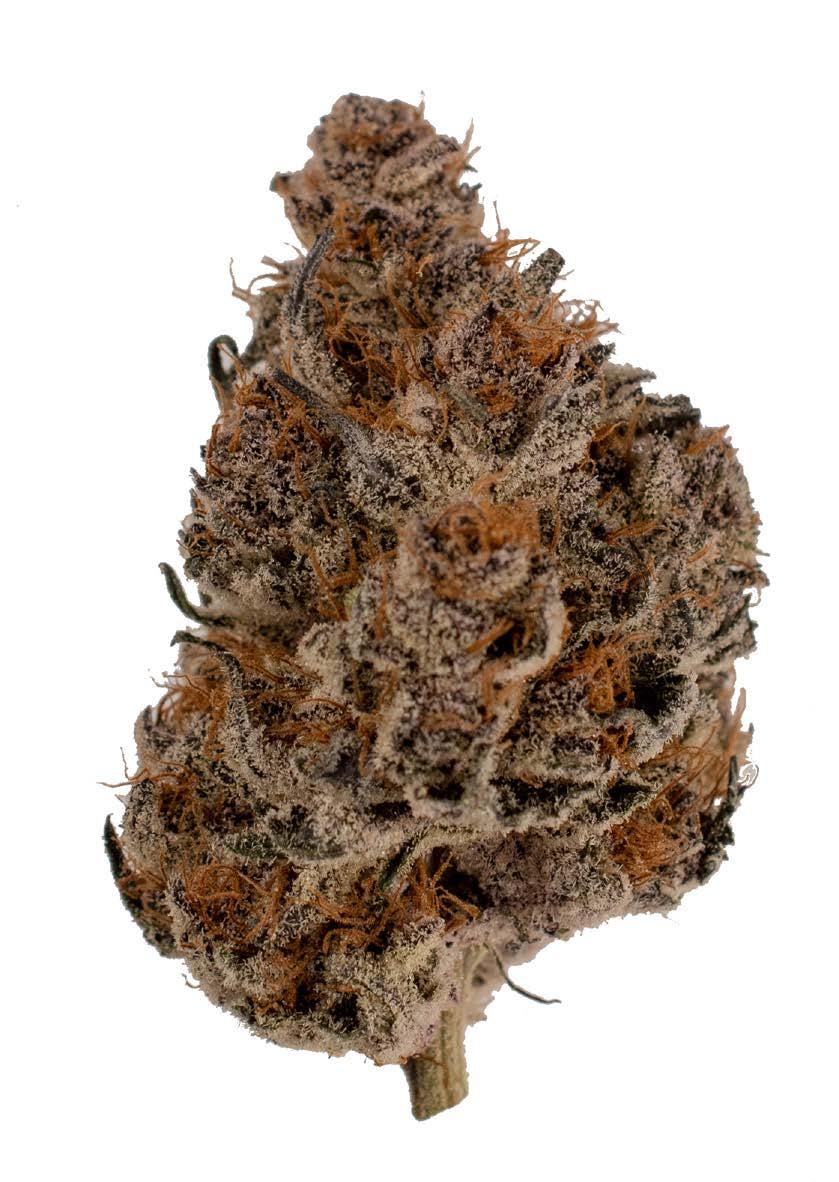









October hums in Northern California. Diesel engines on backroads, scissors clicking in barns, the air thick with the smell of cedar and cut flower. The light goes gold around 4 p.m. and stays that way until the ridge disappears. This is the season everyone waits for and the one that breaks them a little more each year. Across Humboldt, Trinity and Mendocino, harvest is smaller now but sharper. The crews are lean. The fields are tighter, planted with cultivars that can handle heat, fog and the sudden rains that roll in off the Pacific. The farmers who stayed learned to match the rhythm instead of fighting it.

AT NEUKOM FAMILY FARM on the banks of the Trinity River, Cannabis sits beside tomatoes, melons and peaches in the summer, part of the same rotation that’s kept the soil alive for decades. Amy and Jacques Neukom move through the rows like it’s any other crop: water, cut, cure, repeat. They sell vegetables, eggs and joints at the same market stand. Nobody whispers anymore.
“People come for food and ask about the flower,” Amy Neukom said. “It’s just farming now.”
In the Mattole Valley, Dylan Mattole has shifted to washers suited for concentrates, specifically hash and rosin. “Sun-grown is rising to the top in those markets,” he said. “The hash makers appreciate the quality that comes from organically sun-grown flower with unique genetics.”
In Mendocino, Joseph Haggard and his mom, Katie, who helm Emerald Spirit Botanicals, breed for flavor and function, not percentages. Their multiple-award-winning cultivar Pink Boost Goddess gleams under the late light, the scent closer to strawberry jam and flowers than gas. Joseph Haggard said the demand is real.

And in Humboldt, the Humboldt Family Farms collective pulls the pieces together, jar by jar, farmer by farmer. They share transport, packaging and stories — the connective tissue of a region learning how to stay alive inside a system that barely sees it.
Founder Scott Vasterling calls it “logistics with heart.”
The collective’s latest campaign lifted sun-grown sales at Embarc stores into double digits for the first time. Proof, however small, that education works when the weed is good enough.
Harvest is a habit first and a headline second. Regardless of the attention it gets or doesn’t, the farm activity still swells before dawn, and the generators still buzz all night. The people doing it don’t talk about resilience; they’re long past all of that. They’ve built smaller, smarter, steadier lives on land and in a market that keeps asking for everything.
By dusk, the hills glow. The smell carries for miles: terpenes, rain and work. On some ridges, lights stay on all night, and on others, the barns are already full.
The season ends the way it always has: tired hands, quiet pride and smoke rising from the valley like a promise that next year will come around again.

"They’ve built smaller, smarter, steadier lives on land and in a market that keeps asking for everything."
“People want to feel good again. They don’t want to get wrecked,” he said.
Their farm feels closer to a vineyard than a grow site, with sun, soil and intention dictating everything.










I’m looking up toward a sky dappled with clouds and feeling the vibrations emanating from the life-form beside me. It’s a towering Blueberry Pancakes plant, and I’m pushing away from the energy of the group to stand in stillness with the silent hum of its life force.
The Cannabis flowers are a deep emerald green, huge and frosty, and they smell like blueberries at peak ripeness. Held in minimal trellising, the plant’s branches confidently stretch out into the air. Watching it sway in the wind over the valley of oaks below makes me smile. When I touch the flowers, they leave a lingering perfume on my fingertips. This plant is statuesque, natural, beautiful and alive.
I’M ON a Humboldt Seed Company farm in the foothills of the Sierra Nevada near Grass Valley, California, as a part of the company’s 2025 quest to find the world’s best weed. Alongside me on this odyssey are Leaf’s chief operating officer, Tom Bowers, and fellow Leaf contributor David Downs.
This festive occasion in late September brings together a group to de-leaf and buck the flowers for steam distilling into terpenes for their aroma and flavor. Later, I’ll joyously dance in a fog machine that’s wafting the Blueberry Pancakes scent.
I’ll eat whipped cream infused with the plant’s essential essence. I’ll inhale other Cannabis flowers into my lungs as a soft, warm rain begins to fall and a lightning storm sends wavy electric jolts across the horizon.

But when I watch the flowers I’ve “big-leafed” fall into the bin, I feel a bit of heartache at the impermanence of it all. It’s the type of melancholy that can come when we mortals think about what comes in the end for us and for every living thing. And I’ll tell my friends: “There could have been another way.”
In my home grow on my rooftop balcony in Oakland, California, I feel a similar sense of loss when harvest time comes.
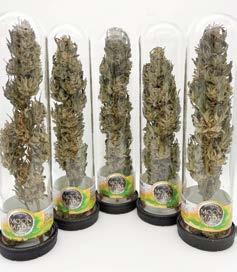
“In the days with the least sunlight ahead, these flowers will provide warmth in the darkest days.”
The Cannabis plants on my front porch provide a welcoming display of lush greenery that I enjoy looking at as they grow and mature. But once the fall comes, they’re gone, and I miss them, even just for their decoration.
A 2022 study published in the International Journal of Environmental Research and Public Health shows that even a small amount of greenery in an urban environment can be beneficial for reducing stress, as elements of nature provide a “soft charm” that allows people to achieve more efficient concentration.
I think Cannabis flowers (and all flowers) are here to teach us about impermanence. With flowers — which grow, blossom and fade — the only real moments are in the now. I smell and smoke Cannabis flowers and remember that their time, and my time, here on Earth will not go on forever.
I’m probably in the minority group of people when it comes to thinking about harvest as an ending for the Cannabis plant and not a beginning to its ultimate purpose: all the weed we’re going to smoke when wintertime arrives. But I know I’m far from the only one to fall in love with a Cannabis plant.
Tina Gordon, the cultivator at Moon Made Farms in Humboldt County, believes the Cannabis plant has three lives. The first life, she said, is when it’s growing in the ground, “and that’s when the cultivator is stewarding the plant.” The second life begins when the flower is cut, and that life continues all the way up to when it’s smoked. The third life starts within the resonance of a person when they smoke that flower.
This third life of Cannabis that Gordon speaks of alludes to our deeply personal connections with this plant because of the way it makes us feel.
I think the reason this plant resonates so clearly with so many different people has to do with the fact that our bodies are built with an endocannabinoid system, which has receptors that bind to the chemical elements Cannabis provides when we ingest it. The endocannabinoid system regulates critical bodily functions. It’s the key to our health and vitality.
Sure, other plants contain cannabinoids. Who can deny the sharp appeal of freshly ground black pepper or the soothing effects of cacao? But cannabinoids are most prevalent in the Cannabis plant. And while we know a lot about this plant, there are still undiscovered cannabinoids. We’re also continually learning more about how the other chemical elements in Cannabis affect our well-being.
The Cannabis plant is our companion that helps us as we navigate through life and guides us toward asking the big questions, like “Why are we here?” Harvest brings a moment of reflection, even though it’s an intense time for growers. It’s a mad rush against the rain, a battle against hungry caterpillars, a phase when a few missteps in drying can ruin a year’s worth of effort. But at a certain point, it’s all over.
“To harvest or render the plant, it’s the culmination of everything that has gone into the plant,” Gordon said. “I mean, it happened. Here she is.”
The seasons help mark the passage of time and offer rhythmic resets that are in line with the Earth and nature around us. It’s best to think of everything, all of life, as an infinite loop. In the same way that there is no beginning, there is no end. Cannabis flowers are meant for smoking. Their ultimate destiny is helping us fulfill our destiny.
We’re getting close to reaping the benefits of the 2025 sun-grown Cannabis harvest. It’s almost time to open the jars, pull out the flowers and set them on fire. In the days with the least sunlight ahead, these flowers will provide warmth in the darkest days. We’ll settle into winter’s reset, and when spring comes, we’ll plant seeds and start over again.
@THEHUMBOLDTSEEDCOMPANY
@MOONMADEFARMS






DO YOU EVER WISH HERB WAS MORE “SET IT AND FORGET IT”?
THE HARVEST ISSUE you’re holding celebrates the end of one annual, full-sun cultivation cycle, but another begins. Some growers are just getting set up for their winter indoor run, and we’re seeing more newbies, as well as pros, grow with “automatic” seeds.
Cannabis that flowers “automatically” does not need the strict lighting schedule of standard weed strains. Like early LEDs, auto seeds have gone from punch line to punching above their weight. Autos used to contain a little THC, with low terpenes and yield, but not anymore. Modern autos smack. Chances are you have smoked or dabbed an automatic plant and didn’t even know it.
Maine cult star Night Owl Seeds — a 6-year-old company and a leader in the automatic seed game — does midnight seed drops, like Strawberry Milk and Qookies, that sell out in minutes. What is company founder/operator Daz’s strategy? Automating classics like Marathon OG, AJ’s Sour D and (soon) Banana OG.
Daz learned how to make auto versions of strains in Europe, which is ahead of the Americas in the automatic weed game. Then Daz worked under Mephisto Genetics until he started his own thing. “I’ve been isolating with plants for 10 to 15 years,” he said.
Daz said automatic weed growers are usually hobbyists working indoors in tents. When Daz finally got the wherewithal to run a large indoor warehouse, he populated it with 40 tents instead of one big grow.
Experts say it’s getting almost impossible to tell the difference between automatic flowers and regulars. All automatics contain genes from a subspecies of weed called “ruderalis.” These rude girls flower automatically on the roadsides of rural Russia. Modern autos lack any telltale ruderalis aroma or taste.

Humboldt Seed Company, the 24-year-old top photoperiod brand, is working on autoing a vast chunk of its 80-strain commercial catalog. Among them, we’ve seen a new fruity auto Hella Jelly F5 with sizzling sativa effects, but it grows short and flowers quickly.
The December 2025 Auto Hella Jelly solves the two major issues commercial growers have with sativas: They get too tall and take too long. Time and space cost money. This squat, pink-flowered strain should take around 90 days from seed to harvest. When dabbing Auto Hella Jelly, you’d never know it’s the distant grandchild of Russian ditch weed. The live rosin is very blond, fruity and delicate, like a sugary confection. It hits light, clean, fruity, loud, strong and bomb, easing tension and energizing work.

Award-winning journalist/author and former Leafly Senior Editor David Downs’ monthly genetics intelligence dispatch.

One home grower in Quebec, Canada, who’s killing it with automatics is gardening influencer Linh Nguyen, aka “Autopotamus.” Sponsored by a raft of genetics and hardware brands, Autopotamus grows bountiful bushels of dank, icy colas that showcase the potential of autos in the 2020s.
Daz said autos grow a bit differently than regular, so-called “photoperiod” strains, which need timed lighting. For one, they don’t like getting transplanted or repotted. Don’t stress autos out.
Autos are harder to grow than photos, Daz said, but once you see the speed, flavor and potency, “it’s hard to go back.”
The American Autoflower Cup, one big sign of autos’ arrival, returns in early 2026 and just announced its seven categories. Registration is currently open. Judging is conducted by industry experts, lab analysis and popular vote.
The awards ceremony is Jan. 31, 2026, at beTRUE Los Angeles.

CANNABIS THAT FLOWERS “AUTOMATICALLY” DOES NOT NEED THE STRICT LIGHTING SCHEDULE OF STANDARD WEED STRAINS.

NIGHT OWL SEEDS MEPHISTO GENETICS
HUMBOLDT SEED COMPANY
MULTIVERSE BEANS
AUTOMATICS
SPEEDRUN SEEDS
I’m running some autos this winter in San Francisco that were gifted to me in July by Cora Genetics founder Hardy Nieto, who just passed away.
I popped a full pack and selected four of the feminized Dr. Grinspoon S1 autos for a big fabric pot. I don’t need the bud, but the fresh terps and joyful bouquet are a living memento mori for the new year. Time flies, so be quick and excellent — automatically.















Mac White is a different breed. When the going gets tough, he just crushes through and perseveres. When he gets a vision, he doesn’t know the word “stop.” “I always looked up to Elbo and Coyle when I was first getting into glass, the way they could make it look like another medium always drew me in,” Mac said.


HIS JOURNEY on the torch started in 2012. When he relocated to Bellingham, Washington, in 2014, Whitney Harmon and I were fortunate enough to have him land at our studio, the Honeycomb Hideout, where he continued to create for another seven years or so before heading off to Albuquerque, New Mexico. In that time, I watched his talents grow to great lengths.
Mac also has a background in freehand art with a lot of different mediums. The mixture of that skill and glass art has made for some memorable pieces over the years.
You will see a couple of examples here where Mac either collaborated with others or made pieces himself. He then went on to freehand etch with graphics of another caliber, making these truly one-of-akind pieces of art.
His most recent drops were at Prism Smoke Shop in New York and Zee Vapor in Illinois. He usually has a piece or two available on his Instagram, so check him out there as well.


I also want to give Mac and his new fiancee, Emma Palmerton, a huge congratulations on their recent engagement, where he got down on bended knee during their trip to Greece! @MACELEVENGLASS









Ripping a bowl releases a smooth and sweet smoke that burns quickly to a white ash, sending a rush of heady, chillaxed euphoria straight to the frontal lobes. The flower tastes amazing when smoked, as notes of citrus, chocolate and the ever-present GMO coat the palate with tingly terpenes while the effects build up.

The first bowl slows time and thought, and the second and third bowls add layers of stickiness to the fingers and load the mind and body like a triple-decker cake of baked. With a superbly easy smoke, we ripped through bowls, savoring the flavor and the feeling of our minds melting into a puddled body below.
Despite the name, we found the Offendo to be the ultimate stress reliever, as it calms muscles and mental tension, relieving us of all ancillary thoughts until only weed, food and music remain. In a time when people are so easily offended and sensitive, perhaps getting baked to the point where those thoughts slip away is truly the ultimate medicine.


Straight out of the woods of western Washington comes a strain that is smelly enough to be mistaken for a ripe Bigfoot, with a buzz that’s the perfect way to kick off a season of change. Offensively loud and funky, the Offendo is shown here in the grow just a few days before harvest.
CANNA ORGANIX is situated in Sequim near Olympic National Park in an area known locally as the “Blue Hole.”
This nickname comes from the rain shadow effect of the Olympic Mountains, which means that Sequim has a fraction of the rain at only 12 to 16 inches per year.
Consider that nearby Forks — hometown of the vampire “Twilight” saga — receives 120 or more inches of rain per year!
Apart from the interesting PNW facts, the weather is relevant because Canna Organix grows using supplementally lit greenhouses, taking advantage of the 300 days of rain-free weather to grow using natural sunlight. The farm also utilizes living soil practices and grows with organic methods that produce clean, tasty flowers that power the lineup of jars, joints, concentrates (like live resin and RSO) and cartridges that can be found all over the state.
With beautiful and chunky nugs, a light green color and a heavy coating of frosty trichomes and red hairs, this flower looks as beautiful in bud as it does in the garden. The first notes from the bag are bright and ripe, with rich red berries, chocolate, coffee and heavy GMO notes dominating the senses.
Breaking open a dense but fluffy nug releases a creamy Gelato funk that brings orange zest and a fuel-mint zing that teases the senses. This strain lives up to the name Offendo, with a dank and robust bag appeal that would turn up the nose of a nonstoner, but gets our mouth watering as we break up the bud.


















In 2008, a personal mission to make Rick Simpson Oil for a father battling Stage 4 thyroid cancer sparked what would become Lazy Bee Gardens — a living-soil, light-deprivation greenhouse farm known for meticulous pheno hunts and terpene-rich flower. Licensed in 2015, Lazy Bee has been refining its soil and selections ever since. Northwest Leaf sat down with Matthew Frigone Bernhard, the farm’s owner, to discuss origin stories, cultivation philosophy, genetics and a few big-picture hypotheticals.

WHEN DID YOU START GROWING, AND HOW DID THAT BECOME LAZY BEE?
I started growing in 2008 to make Rick Simpson Oil for my dad, who had Stage 4 thyroid cancer. That’s where the passion for this plant began. I grew medically for six years, and when recreational legalization happened, an opportunity presented itself. I took it. I began building the farm in the summer of 2014, was licensed in February 2015, and our first commercial harvest came that summer. We’ve been cultivating the plant we love ever since.
WHAT’S YOUR GROWING METHOD?
Water-only, no-till living soil beds — our native soil, heavily amended over years to get it right. I’m a big fan of practical permaculture. All Lazy Bee flowers are grown in light-dep greenhouses with raised beds. It took a few seasons to build the soil to true no-till; it’s been seven years now, and it keeps getting better. We never use bottled nutrients — ever. We focus on microbiology and true living-soil practices.
HOW MUCH DOES THE WEATHER PLAY INTO YOUR HARVEST?
Not a lot. The greenhouses and light deprivation let us pull flower before the weather turns. Late hoop-house crops typically go to our other brand, Ra Cannabis, or into concentrates. My favorite runs come in June/July; the light spectrum and temps are ideal for most genetics.
>>CONTINUES PG. 42





WHAT’S NEW IN THE GARDEN?
New genetics this season: Tropical Runts and Rainbow Beltz — both turned out amazing. Reworks: Makeup Sax and Almond Brittle — also great. We had a terrific year. This winter, we’re working breeding projects with Where’s My Bike, aiming to bring that into our Aethernet line in search of the terp profile our old Tesla Tower used to have. I’ve been chasing that profile for over half a decade — we’re getting closer.
WHAT HELPS TO MAKE LAZY BEE STAND OUT FROM OTHER FARMS?
It’s a mix of method and genetics, but genetics probably edge it out. A novice with the right genetics can grow fantastic flower; a pro with bad genetics will top out at mid. Method still matters — for terp and cannabinoid diversity, cleanliness, smoothness and yield — but you must start with good genetics. I’ve hunted thousands of seeds from various breeders and our own work, and trialed hundreds of clones. Selection is everything. It’s a lot of work, but when you find a keeper, the juice is worth the squeeze. Pair that with organic, sustainable practices and amazing retail partners — that’s been key to our success.
“WE NEVER USE BOTTLED NUTRIENTS — EVER. WE FOCUS ON MICROBIOLOGY AND TRUE LIVING-SOIL PRACTICES.”
WHAT DO YOU WANT TO SEE ON SHELVES: LEGACY STRAINS OR THE LATEST HYBRIDS?
A healthy balance. We still run legacy classics like DJ Short Blueberry and Blue Dream, and we also cycle in fresh winners from ongoing hunts. There’s room for both. I also love playing with old-world genetics — less commercial sometimes, but really fun.
TIME MACHINE QUESTION: PAST OR FUTURE? The past. You can learn a lot about the future by studying it; cycles repeat. Plus, you’d get to meet people we know existed from history. The future would be fascinating, but with less context, it might be harder to digest.
DEAD OR ALIVE, WHO WOULD YOU MOST WANT TO SPARK A JOINT WITH? Enoch.


Location
Winthrop, WA
Methow Valley
Signature Strains
Powder Hound (S)
DJ Short Blueberry (I)
Grape Gasoline (I)
Kiwi Daquiri (S)







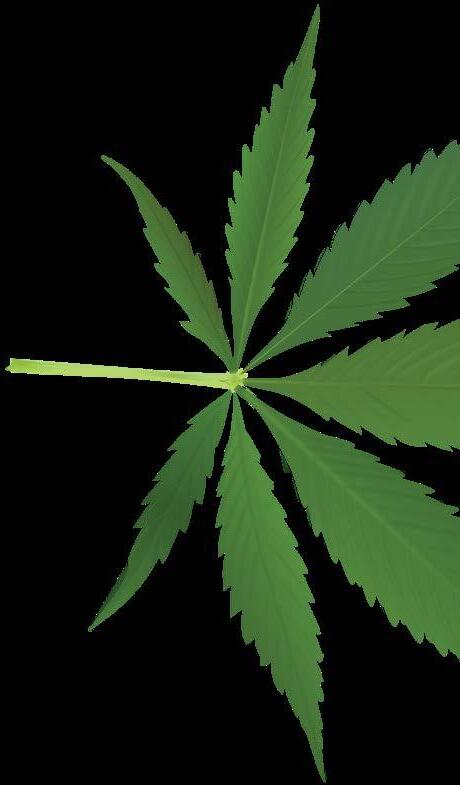















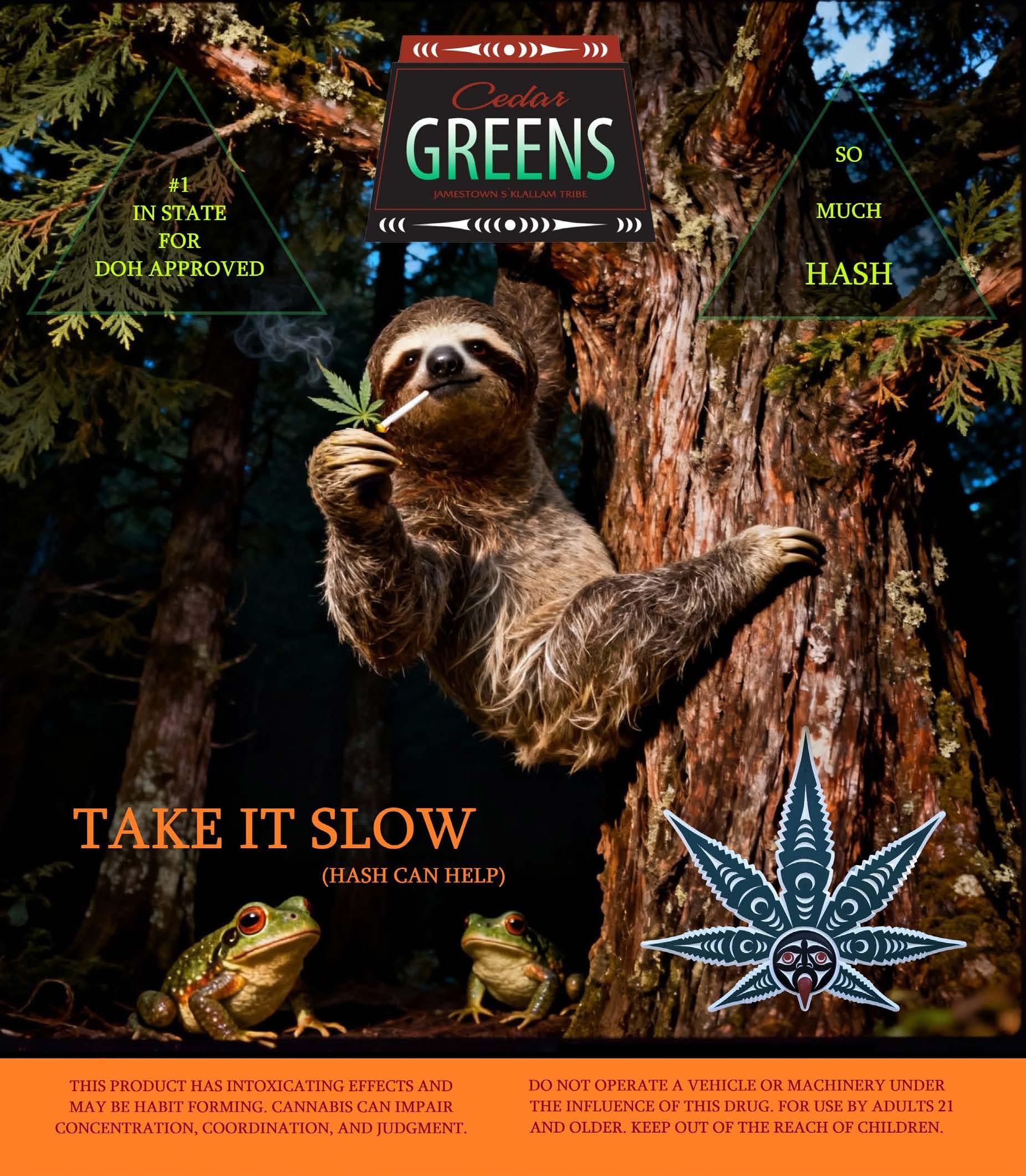



Just north of Omak, you will find a particularly special Tier 3 Cannabis farm called CannaSol. It’s surrounded by vast amounts of other agricultural endeavors. From apples, pears and cherries to peaches, apricots and nectarines, this hallowed ground has produced some of the best fruits in the world for centuries


TO UTILIZE THIS SOIL, you have to know more than a thing or two about botany, and that’s where CannaSol Farms’ proprietors Jeremy Moberg and Sabina Boehm, come in. They’ve spent more than a decade perfecting what others have spent a lifetime on: creating living soil that doesn’t require salt-based nutrients to grow prolific Cannabis plants. What are terpenes? It’s a really good question because for a lot of us, that’s all we’re after. Terpenes are the taste on your palate, and they make marijuana one of our favorite things to ingest. Sure, the medical benefits and cerebral feelings also help drive purchasing
decisions. But for me, first and foremost is the flavor, and that all comes back to the terpenes.
But there’s a certain way to get the most terpenes out of a plant, and CannaSol follows these ideals precisely by providing a natural stress to the plant with perfect lighting and timing. Now, light deprivation might not sound like the highest tech thing. A lot of people might think it’s just an outdoor grow with a tarp, but it’s more than that. Out in the elements, the blazing sun and blowing winds give plants optimum space to breed both terpenes and cannabinoids. >>CONTINUES PG. 48


AWARDWINNING CULTIVATORS

Location
Okanogan County
Signature Strains
Acapulco Gold
Jack Herer
Durban Poison


“ONE OF THE MOST NOTABLE THINGS I SAW ON THIS TOUR WAS THE DEDICATION TO ENVIRONMENTAL SUSTAINABILITY.“



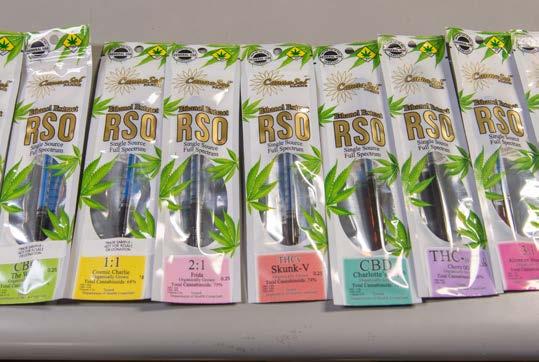
NOW, TO GO BACK AND SIMPLIFY THINGS, cannabinoids are what get you high. They’re produced by a certain mechanism of photosynthesis that occurs within the Cannabis plant. Potency is based on an hourly light schedule, a certain amount of nutrients that the plant absorbs through the soil (or substrate) and a monoculture that allows you to procure the best plants for particular benefits. But terpenes are different; they’re what you taste and what makes Cannabis enjoyable. Without stress in the environment, terpenes aren’t as readily available. Sure, you might grow the perfect indoor crop and get a batch that really spits when you put it on the press, but the best flavor comes out of a plant that has experienced actual natural homeostatic stress.
CannaSol focuses on this mantra and takes it to the next level. One of the most notable things I saw on this tour was the dedication to environmental sustainability. For example, CannaSol uses organic, handmade compost tea to feed the plants, and they also design and source packaging that limits the amount and types of plastics used. Everything at this farm is well thought out and focused on intentions. These practices garnered CannaSol the coveted Dr. Bronner’s Sun+Earth Certification.
Next time you visit your favorite retailer, give CannaSol a try. Flower, prerolls, rosin, edibles and a full line of RSOs are just some of the products they produce in-house. CannaSol Farms also produces Cannabis for its two other brands, Lish Organics and Columbia Natural Cannabis, so make sure to check out those products, too.


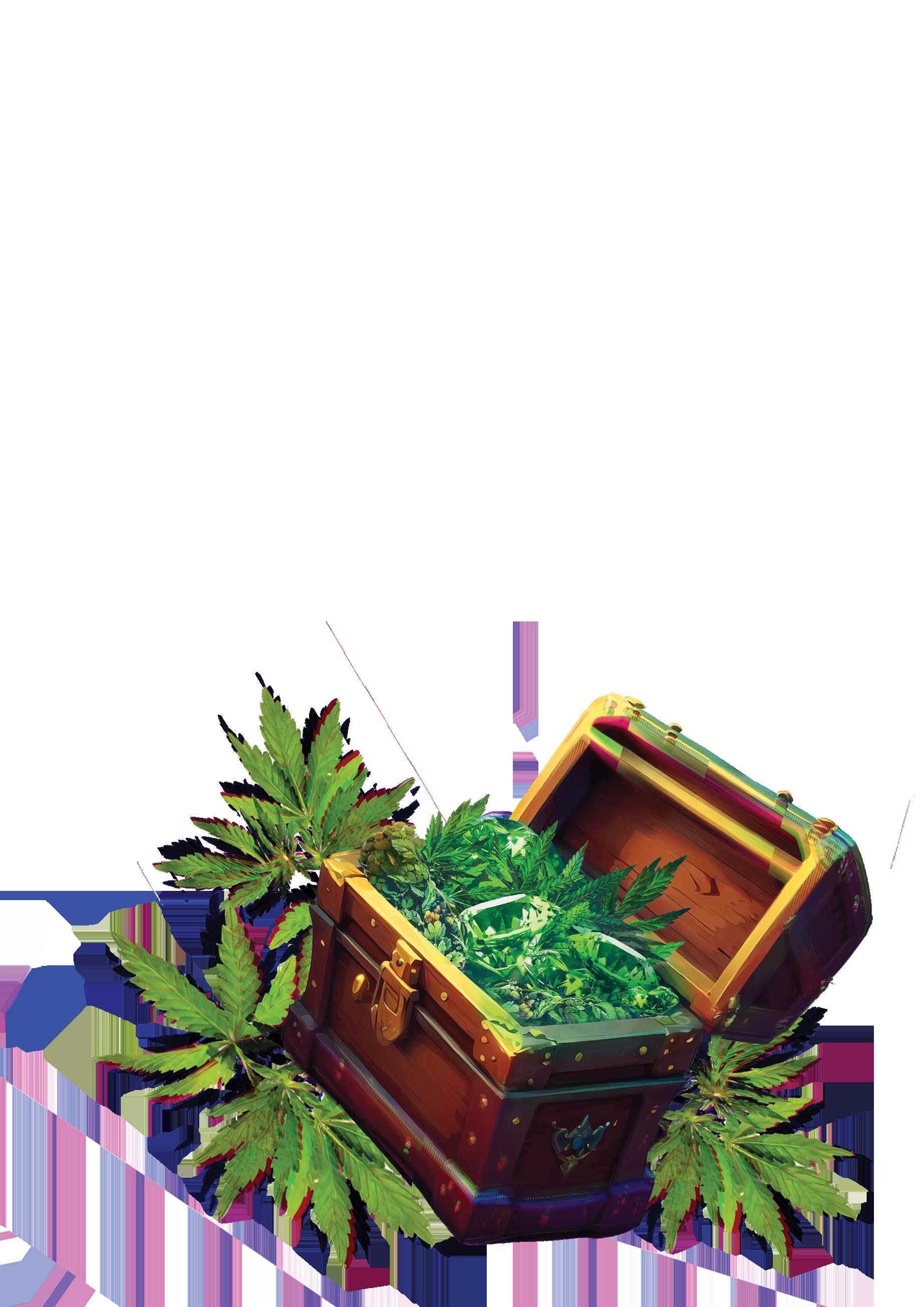











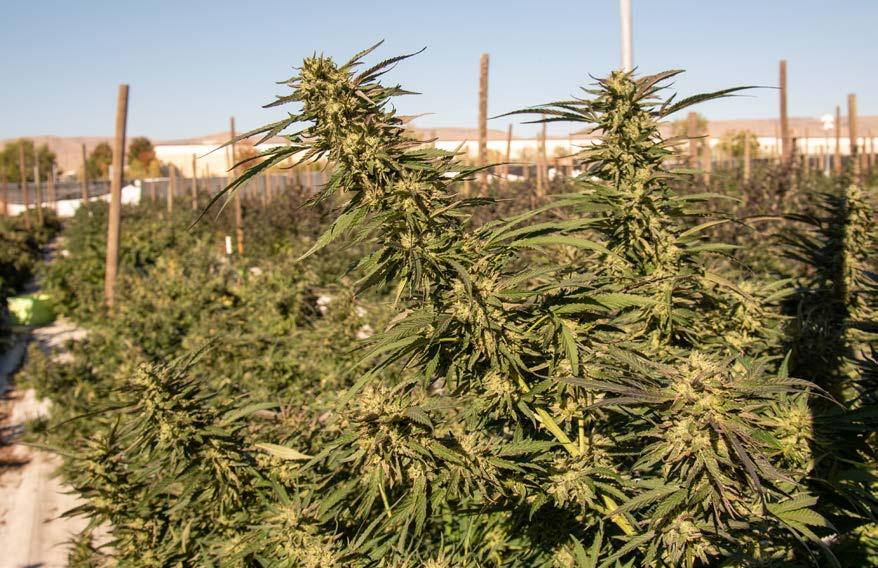
I LEARNED that the Cannabaceae family of plants has 11 genera and around 170 species. The two most popular genera are Humulus lupulus (hops) and Cannabis sativa (hemp), which both require almost identical growing conditions. I really went down the rabbit hole here, and I suggest you get online and do the same.
Basically, ideal growing conditions for hops and hemp consist of lots of long, sunny days, nutrient-rich and good-draining soil, and not too much moisture in the air. So, that means that the Yakima Valley is probably the most optimal place in our country to grow Cannabis outdoors.
“We focus on treating our sky-lit flower like we would if we
were growing under lights, not skipping steps or taking shortcuts,” Douglas “DH” Henderson, Painted Rooster CEO, stated. “The best way to ensure quality is to stick to the basics and focus on what the consumer deserves from us; and that’s the best cured and preserved full-term flower the state can produce.”

Northwest Leaf saw this ethos in action on the tour: immaculate working conditions, a superbly clean processing facility and fields that are cared for by hand. Each team member I met had a genuine smile and a specific task, which shows efficiency, something that this legacy farm has built over its years of operation.
>>CONTINUES PG. 54
“PAINTED


THE MARKET ...“
ROOSTER PROVIDES SOME OF THE HIGHEST-RATED CANNABIS AND CONCENTRATES ON


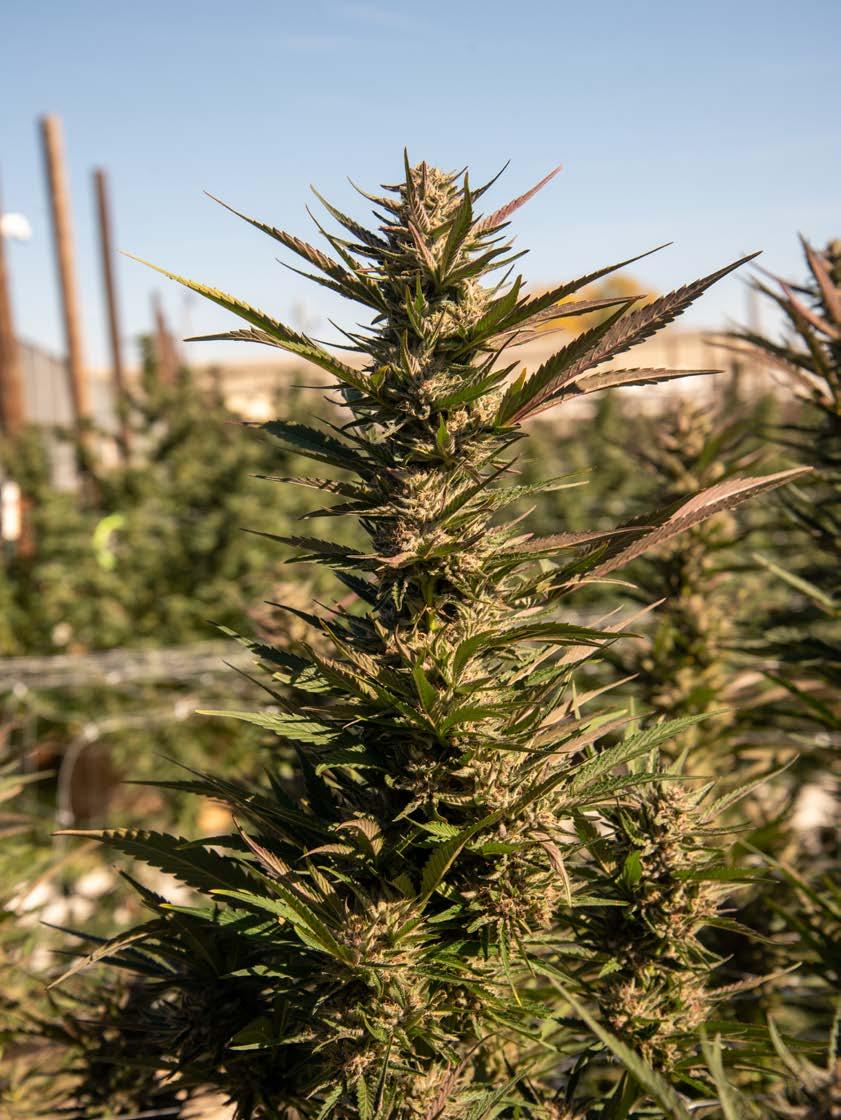
DOUG IS ALSO THE BOARD VICE PRESIDENT OF THE CANNABIS ALLIANCE. As stated on the group’s website, “The Cannabis Alliance is a nonprofit organization dedicated to the advancement of a vital, ethical, equitable, and sustainable Cannabis industry in Washington state.”
Through this industry-founded and -operated entity, his leadership and the team have helped march forward the ethics involving farms and are working toward a future with farm-to-table aspects of this craft.
As Doug clearly conveyed during our interview, “Washington growers are frustrated with their allowable access to consumers due to current limitations on advertising and marketing put in place by the LCB.”
With plenty of Leaf Bowl awards to prove it, Painted Rooster provides some of the highest-rated Cannabis and concentrates on the market. And, on top of that, it also produces arguably the most-consumed, highest-quality infused beverage on the market.
All made on site, from seed to processing, it’s called Sungaze, and this probably isn’t the first time you’ve heard the name. This amazing seltzer is a delicious beverage as well as a great entry-level introduction to Cannabis consumption.
The mellow flavors and moderate strength keep it at the top of the list for many enthusiasts, new and old.
I’ve found that it’s a great late-afternoon libation and a perfect addition to a cocktail or mocktail.
At the end of the day, this team strives for perfection on every level. Do yourself (and your friends) a favor: Grab a sixer of Sungaze and some G-Stiks prerolls for your next sesh. Because, as stated on the Painted Rooster website, “nothing but the utmost quality will be presented in your jar, glass, or joint. If we wouldn’t smoke it, we wouldn’t sell it.”




WARNING - May be habit forming. For use only by adults 21 and older. Keep out of the reach of children.It is illegal to operate a motor vehicle while under the influence of cannabis. This product is not approved by the FDA to treat, cure or prevent any disease. Unlawful outside Washington state. Smoking is hazardous to your health.

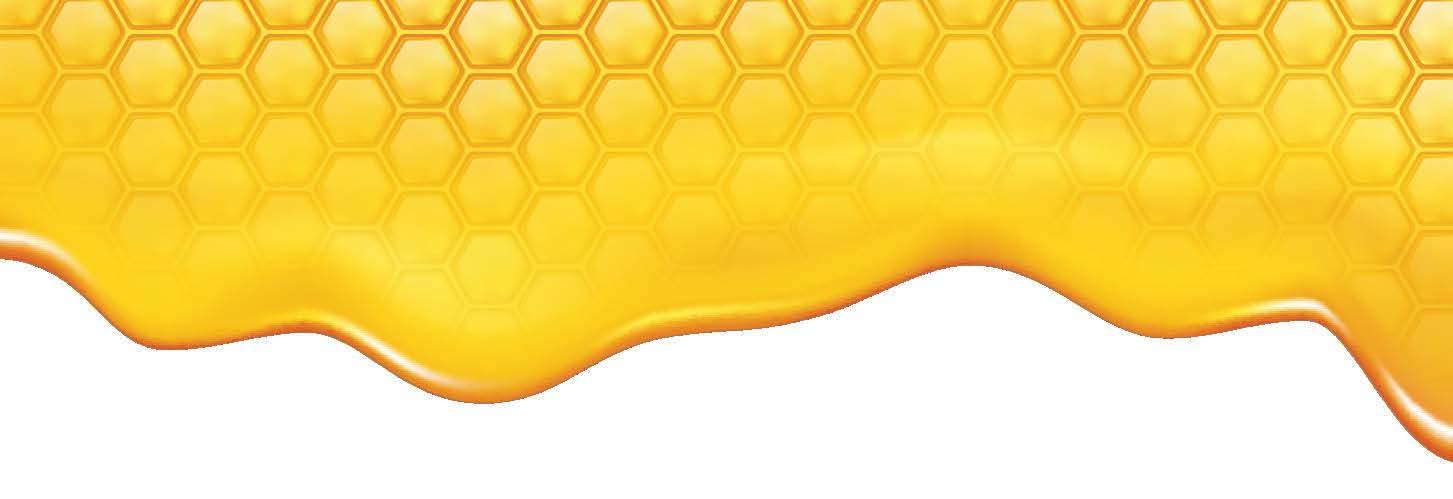









It’s easy to get lost in the static of modern society: the constant scrolling, the 24-hour news cycle, the endless hum of distraction that leaves our souls hungry for meaning. In these noisy times, there’s a quiet revolution waiting right outside our doors.

By putting down the remote, turning off the endless stream of social feeds, picking up a pair of gardening gloves and visiting your local farmers during gleaming season, you can take a gentle yet radical stance against chaos. Tuning into the rhythm of the harvest season isn’t just about gathering food; it’s about remembering who we are as beings deeply rooted in Earth’s sacred cycles.
Across the Pacific, the Hawaiian tradition of Makahiki invites us to return to this remembrance. Stretching from late October through early February, Makahiki marks the Hawaiian harvest season and New Year, a time of peace, rest and gratitude for the abundance of the land and sea.
This season was dedicated to the god Lono, the divine spirit of fertility, agriculture, rainfall and peace.
Ancient Hawaiians celebrated Makahiki by halting all wars and hard labor, offering tributes — crops, fish and handmade goods — to the temples and coming together for games, feasts, chants and dance. It was a sacred pause in the year, a collective deep breath that honored both the land’s generosity and the community’s unity.
The simple act of touching the soil and watching something grow nurtures our spirit as much as it feeds our bodies. Studies show that the microbes in soil can boost serotonin levels, lifting your mood naturally, while the rhythmic, repetitive motions of planting and pruning promote a meditative state that eases anxiety and stress.

The cultural significance of Makahiki runs deeper than ceremony. It embodies the Hawaiian value of pono: living in balance and righteousness with all things. In today’s fast-paced world, Makahiki reminds us to slow down, share our harvests and celebrate the simple joy of being alive together.
The festival games, laughter and music symbolized more than leisure; they represented harmony between people, nature and the divine. Imagine a season where everyone collectively agrees to rest, reflect and give thanks without conflicts or competition — just gratitude and play. That’s the spirit of Makahiki: joy as resistance, peace as abundance.
Bringing that same energy into our own gardens can be a form of modern resistance, a personal ceremony of gratitude and grounding. Whether you’re tending kale in your backyard or basil on your balcony, cultivating your own food reconnects you to the natural cycles of life. Gardening invites stillness, mindfulness and patience, qualities that are rare jewels in today’s hurried culture.
When you harvest what you’ve grown, the reward isn’t just in flavor; it’s also in feeling. There’s a deep ancestral joy that bubbles up when you pull a carrot from the ground, clip a sprig of mint for your tea or roll up some good ol' home-grown pakalolo. You’re not just collecting produce; you’re participating in a sacred exchange with the Earth. As the ancestors knew, to eat from the land is to be fed by spirit. If you’re ready to cultivate peace in your own corner of paradise, start small. A few potted herbs on a sunny windowsill can become a daily ritual of reconnection. Let gardening be your meditation. Focus on the feeling of soil between your fingers, the sunlight on your skin and the sound of water trickling through roots. Embrace imperfections, as gardens teach resilience and acceptance through their natural cycles of growth and decay. Create your own sanctuary space. Breathe deeply, release the noise and simply be present with the mana aloha of the land.
And don’t forget to share the harvest. Invite your neighbors over for a fresh salad, trade ‘ulu (breadfruit) for kalo (taro) or gift bundles of freshly harvested herbs wrapped in twine. Community is at the heart of every harvest. Just as Makahiki once unified entire islands through collective gratitude and celebration, so, too, can we weave joy and belonging into our local ecosystems, one seed, one smile and one shared meal at a time.
So, as the season shifts, remember, OGs, the Earth doesn’t scroll — she cycles. She grows, decays, rests, renews and remerges, and so can we. May the spirit of Makahiki inspire you to celebrate life wherever you are, and may your harvest be plentiful in food, friendship and the peace that comes from living pono: in righteous harmony with the Earth.





ONLINE VIA ZOOM, 10AM - 4PM

FEAT. CONTRACT LOBBYIST AL RALSTON, GUEST LAWMAKERS, LEGISLATIVE ASSISTANTS, & CAUCUS STAFF
GET READY FOR THE UPCOMING LEGISLATIVE SESSION WITH THE CANNABIS ALLIANCE’S POLICY BOOTCAMP– A CRASH COURSE DESIGNED FOR ANYONE WHO WANTS TO BETTER UNDERSTAND AND ENGAGE WITH WASHINGTON’S POLICYMAKING PROCESS.
WHETHER YOU’RE BRAND NEW TO ADVOCACY OR JUST WANT TO SHARPEN YOUR SKILLS, THIS BOOTCAMP WILL GIVE YOU THE TOOLS AND CONFIDENCE YOU NEED TO PARTICIPATE EFFECTIVELY IN THE LEGISLATIVE PROCESS.



With his long, colorful dreadlocks, braided beard, hemp clothing and exquisite crystals, Marc Rossman — better known as Soma — comes across more like an Eastern guru than a Dutch seed merchant. That’s because this Amsterdam-based American expat has devoted his entire life to the hippie ideal, new age spirituality and the sacrament of Cannabis — earning himself a reputation as one of the world’s most beloved breeders.
Marc Rossman was born on August 22, 1949, in Pittsburgh, Pennsylvania, to middle-class Jewish parents of Slavic descent. When he was just a year old, his mother and father divorced. Two years later, she moved him to Queens, New York, and remarried. After graduating high school at age 17, he tried to join the Air Force but was rejected due to a kidney condition called orthostatic albuminuria. Instead, he spent the Summer of Love sorting mail for IBM on Madison Avenue. Fate, however, had other plans for him.
“One day, a mail carrier from another office came in and asked me if I’d ever smoked marijuana,” Rossman recalled. “I said, ‘No, but I’d like to!’ The next day, he brought me 15 pin joints for $5! So, right after work, I walked down the East River and lit one up. By the time I finished smoking it, I thought, ‘Wow — I really like this stuff!’”
Rossman started smoking regularly, growing his hair long and wearing pastel-colored shirts, eliciting a reprimand from his boss.
“He said, ‘You gotta get a haircut, and this is a white-shirt-only place.’ And right then and there, I said, ‘I quit.’”
FROM MADISON AVENUE TO MADISON, WISCONSIN
Rossman spent the summer of 1969 in Haight Ashbury, where he lived in a commune, dropped acid and smoked tons of weed. When the commune disbanded that fall, he headed back to New York and drove a yellow cab for about a year. But after finding the city inhospitable toward hippies, however, he moved to Madison, Wisconsin, in 1970.
Once there, he went vegetarian, became a “Jesus freak” (his words), gave up weed and learned how to bake organic bread. For months, he lived sober and celibate on an all-male Christian commune, studying the Bible and proselytizing on the streets. That is, until one night, when he was preaching to a topless dancer and ended up breaking his vow of chastity, after which he was cast out.

BAKED & BAKING
Rossman decided to utilize his newly acquired breadmaking skills to open a bakery. After purchasing some used equipment in New York, he and his best friend moved up to Putney, Vermont, and opened a bake shop/vegetarian restaurant called Salt of the Earth.
After work, Rossman would sit in his second-story boarding room, roll joints and toss seeds out the window. Then, one spring day in 1971, he noticed that around 20 little pot plants had sprung up under his window. He uprooted them and replanted them near a friend’s cabin in a secluded knoll up on Putney Mountain. But that August, just before harvest, park rangers discovered the plants and chopped them down. Rossman and his friend were both arrested and sentenced to a year of probation.
MUSHROOM MARC
It was also while in Vermont that Rossman first tripped on psychedelic mushrooms. Shrooming had such a huge influence on him that he decided to abandon his bakery and go find somewhere to pick them.

He read a book called “A Key to the American Psilocybin Mushroom,” which apparently stated that the best place to find them in the wild was Alachua County, Florida. And so, Rossman and his friend drove down to Florida in search of free shrooms.
Once there, they asked a random hippie where they might find some wild mushrooms. The hippie directed them to a specific farm, where they climbed over some barbed wire and started looking for cow pies. But within minutes, a

pack of bloodhounds and a shotgun-toting farmer were chasing after them. Needless to say, they hightailed it out of there … but not before the farmer unloaded a barrel full of buckshot into the side of the car.
Luckily, they later found a location that was less dangerous and more fruitful.
“We found a magic field with no problem from farmers,” Rossman recalled. “It had so many mushrooms that every time we went picking there, we’d fill up our straw baskets to the brim, and we did that every day for a while.”
Eventually, his friend decided to head home, but Rossman stayed — pitching a tent in the woods next to the “goldmine” field and continuing to gather shrooms, which he then dried and traded for his necessities in Gainesville. “For a whole month I went without any physical money — I only had the mushrooms I’d picked to trade for all my needs,” he boasted. “I became known as Mushroom Marc.”
While in Florida, he was also able to begin growing his own weed using seeds he’d saved, including Colombian, Southeast Asian Thai, Ruderalis Afghani and even an all-American local variety called Gainesville Green.
Unfortunately, in 1980, police raided his outdoor grow, seizing around 200 kilos of weed. What’s worse, he also got into cocaine and heroin during this time, and ended up serving 25 months of a four-year sentence for drug trafficking. The only silver lining to his incarceration was that he went cold turkey and never looked back.

“I was given 14 different kinds of Cannabis to judge, and every single strain in those days had seeds, so I ended up with like 200 seeds.”
In 1994, Soma invited Jack Herer to speak at his hemp shop. During that visit, Herer told him that he was traveling to Amsterdam in November to serve as a celebrity judge at the Cannabis Cup and asked if he’d like to come. Defying his probation, he accepted the invitation and was also made a judge by High Times.

or rather on “Amos Washington,” a new alias created specifically for the magazine (“Amos” being “Soma” backward). Soon, he was writing articles for them, as well as for 15 other international Cannabis publications and websites.
In 1999, he gave his first grow seminar at the Cannabis Cup and won third place Indica for his Reclining Buddha
After his release from prison in 1985, Rossman wanted to get as far away from Florida as possible. So, as soon as his probation ended in 1991, he hopped in his camper and headed to Oregon (where Cannabis was only a misdemeanor). There, he stayed with a buddy in the mountains, who taught him how to grow organically and gifted him with some starter strains, including Big Skunk Korean. With his new knowledge and genetics, he moved down to Eugene and started his first organic indoor grow in his attic with his daughter Willow’s boyfriend, Anthony. Just before harvest, they shot some photos of the garden. When he sent Anthony to get the film developed, he made sure to specify not to give a name. But Anthony foolishly gave them the house’s phone number, and the developer called the cops on them. The garden was raided, and Rossman took responsibility to protect his kids. As a result, in 1994, he spent six months in Eugene County jail before being released on another three-year probation.
In 1993, Rossman also opened Sow Much Hemp — one of the first few hemp stores in America. The shop only lasted for two years, but at least one aspect of it had a far more lasting legacy.
“That’s actually where I came up with the name ‘Soma,’” Rossman explained, “from the name of the shop — ‘Soh-Muh’-ch Hemp.”
“I was given 14 different kinds of Cannabis to judge, and every single strain in those days had seeds, so I ended up with like 200 seeds,” Soma told HT in 2014. “I labeled them, smuggled them back to America and planted them all. I started mixing the Amsterdam genetics with my own and ended up with all of these new crosses.”
Among the many new varieties he later developed were Afghani x Hawaiian, Buddha’s Sister, Amnesia Haze and Hash Plant. Soma turned this impressive library of genetics into his own underground seed bank, Seeds of Courage.
Needless to say, he had the time of his life in Amsterdam. “We got so inspired by the Cannabis freedom that existed there that when we got back to America, we said, ‘Let’s move there.’”
By the end of 1995, Soma had fulfilled his dream of expatriating to Amsterdam — moving into a warehouse space recommended to him by Gene from Serious Seeds. Since he’d jumped probation back in Oregon, he put everything in his girlfriend’s name so it couldn’t be linked to him.

Nevertheless, his home grow was raided within his first year there; apparently, Serious had previously grown at the space, so the “politie” were hip to it.
Soma had around 750 plants, all of which were chopped down — including his 51 mother plants. Luckily for him, since they’d left a few bottom branches, he was able to revive half of them. And despite the large number of plants, he says he only spent six hours in jail, thanks to a friendly pot-smoking officer who declined to file charges after appropriating one of Soma’s plants for himself.
Over the next few years, Soma’s relationship with HT continued to grow. In 1996, HT’s cultivation editor Chris Simunek wrote two articles on him —
— the first in a long string of Cup wins over the next several years.
Since rebranding his company from Seeds of Courage to Soma’s Sacred Seeds in 2001, Soma’s ge netics have won many more awards, and he has judged numerous other competitions.
This past May, Soma had a stroke at age 76, causing him to “lose his mind for a little while.”


“All of a sudden, I couldn’t communicate,” he confessed. “I stopped being able to speak. (My granddaughter Lexis) was asking me a question, and my reply was total gibberish. I also lost a lot of my memory.”
In addition to cognitive issues, he also began experiencing up to a hundred seizures a day. When news broke about Soma’s condition, there was a massive international outpouring of love and support on social media.
“I felt it all,” Soma beamed. “I felt more good wishes from around the world than I ever did in my whole life. It helped me heal.”
After 13 days in the hospital’s stroke ward, he was released with some medication as well as a renewed commitment to Cannabis and the spiritual mindset he’s famous for.
“Cannabis and the eight pills a day that I’m taking are keeping me alive now,” he reflected. “The main thing that I try to integrate with, at this point in my life, is love and kindness and how I can share those energies … through Cannabis, mushrooms, crystals or other ways. Because for me, those are the most important things in this existence, and existence is such a gift.”

Hear Bobby’s extended interview with Soma at worldofcannabis.museum/podcast or search for “Cannthropology” wherever you get your podcasts.



A SOUTHERN CALIFORNIA KID, Shur got his Bachelor of Fine Arts in printmaking at California State University, Long Beach. In 2018, at a studio on campus, Shur said he encountered an airbrush paint gun, went home, ordered a cheap set online and started teaching himself.
Seven years later, airbrushing is the most requested medium by his graphic design clients, though he mostly produces digitally now, as it requires less space and is most often used for apparel.
With a portfolio that includes work for Fleetwood Mac, ZZ Top, Green Day, Creedence Clearwater Revival and the Grateful Dead, many of Shur’s illustrations and paintings carry a vibe that evokes classic rock and the lava lamp era.
He describes his art — which often looks like it belongs on black velvet — as “vintage head shop through a fun house mirror.”
Growing up in Los Angeles as part of the skate and punk music scenes, Cannabis is “just part of something you're going to run into when you're a part of those subcultures,” Shur said.
As far as his artistic process goes, he said weed helps him calm down and focus on the task at hand.

“I feel like I'm a really fastpaced person to begin with,” Shur said.
“Weed helps even that out, so I can calm down and really get into it as long as I don’t have anything important to do afterwards. Plus, listening to music’s always more fun when you’re stoned.”
The Leaf asked him: What’s currently on repeat in the studio? Shur said he often goes on heavy kicks of certain music styles, and right now, the classic rock bug hit during a trip to South Korea a month ago.
“I was in the hotel in the middle of the night blasting Hendrix and Motorhead. That’s how the tear started.


Now I’m stuck on Hendrix’s Electric Ladyland.”
Shur told the Leaf he began working with Cannabis clients, like Jelly Wizard and Dammit Bobby, around 2019, shortly after he started airbrushing. He said people in the Cannabis space are good about collaborating on a solid jump-off point or letting him run with the vision he has in his head.
When asked what he thought first drew people from the Cannabis industry to his art, he said, “Everyone loves a blacklight poster.”

KSHUR.BIGCARTEL.COM
@NOT.SHUR


“I FEEL LIKE I'M A REALLY FAST-PACED PERSON TO BEGIN WITH. WEED HELPS EVEN THAT OUT …"

